While practice might not make perfect, it should at least make you better. Coach Larry Wise explains how to structure a practice session to achieve just that
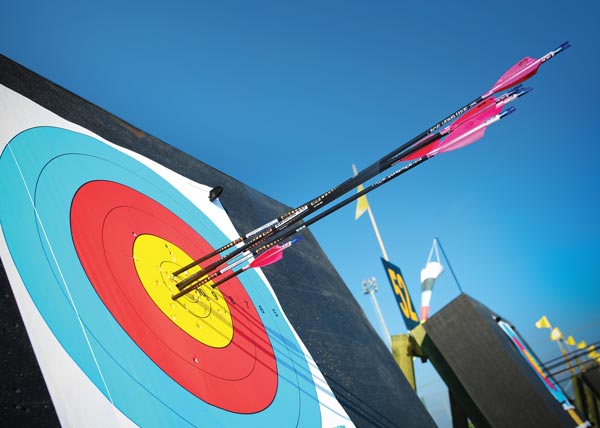
It’s fine to throw in the towel when it’s not going well. It is also smart!
Practice is a very big part of your metal game, as well as your physical one! You manage your practice mentally by analytically focusing on each individual skill you need to improve, and without practice how will you get better? So, as a coach I ask my students the following questions about their practice sessions:
– Why did you practice last Wednesday?
– What did you accomplish?
– Did you shoot a score? What was it?
– What part of your form did you work on?
– What bow tuning did you do?
– Are you better now than you were two weeks ago?
– Or a month ago?
And the really big one,
– Why don’t you know the answers to the first seven questions?
If you are serious about improving your shooting, you’ll know the answers to these questions. You’ll know them because you know how to properly build a practice session and keep track of your progress.
Practice Structure
Here’s what you need to do during your practice sessions. A good practice has the following parts:
A warm up/stretching period
A blank bale/no sight/no target period
A scoring round
Bow tuning as needed
A practice-ending blank bale session
Stretching/cool down
Writing training notes
Let’s look at each of these ingredients to see how many arrows need to be shot, what scoring needs to be done, and the record keeping needed to hold it together and keep you moving in the right direction.
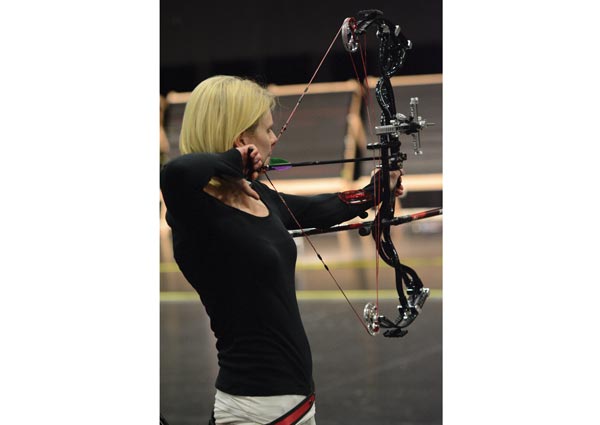
Blank boss shooting is an effective way of focusing on elements of your technique
Part One: The Warm Up
Starting cold is your enemy. Starting time is the most likely time you’ll injure yourself because your muscles aren’t ready to work at their highest efficiency. To shoot your best at tournaments you must practice at your best, and that means warming your muscles a little before your first arrow.
I like to take a short walk before practice, but stretching with a rubber exercise band is a good warm up technique also. There are lots of articles already in print on how to use the stretch band to prepare for practice and tournaments, and you can find these devices in sporting goods stores that handle exercise equipment. Having the discipline to do it is what you have to work on.
Part Two: Blank Bale Practice
This is where real archers are made, in front of the bale with no target, no sight and a plan. Without the plan of what to work on, blank bale shooting won’t help a thing except conditioning for endurance. Your biggest job is to make a plan for each practice session. In fact, you should have a plan for the full week, month, or even longer if you have a tournament on your schedule.
The plan, of course, must be geared toward form improvement – you must make your process better. I’d recommend starting with your weakest form element closest to the beginning of your shot sequence. In my form development method of Core Archery the first step is “stance”. If your stance is fine, then move to the next step which is “bow hand position”. Set your objective before you begin each practice session.
Build form step-by-step until each step is correct. Then, and only then, move to the next. For example, most of my students in shooting schools need to work on bow hand position so when I write a three-week correction plan for them to follow it focuses on hand position first.
During these practices they must focus only on hand position. They must make sure they set their hand properly at the first touch to the grip area. “Feeling” is what they must establish and engrain into their subconscious, and you can’t do that well while aiming. It is best done while shooting with no sight and no target so you can maintain conscious focus on managing your bow hand. It’s even better to practice it with your
eyes closed.
Much research has been done on the subject of practice and it points to the fact that humans need about 20 days to establish a new habit. So, plans to improve a form step must be at least that long. Here’s where it’s nice to have a coach to check on your progress. You need feedback so you know when you’re getting it right or require some help getting back on track again. You can also use a video camera to help yourself. A look at yourself every few weeks can show you if what you think you are doing is what you are really doing.
After three weeks of progress you may introduce a second form change into your blank-bale sessions. Work on the next weak element in your steps of form. Always build up from your stance – like building a house from the ground up – and always build in front of a blank bale.
30 to 40 arrows are sufficient for a blank bale opening practice. More can be shot after you do bow tuning and a scoring round. High quantity is not your priority here, quality is. You should focus on each arrow and how to manage the particular form element you are retraining.
To get best results you should shoot four or five arrows per end and take your time with each arrow. In fact, if you can manage four or five short (10-arrow) practices a day you would learn and retain your new skill quicker, but that’s not convenient for most people so we build one effective session instead. The important thing to remember is staying focused the given element on each shot.
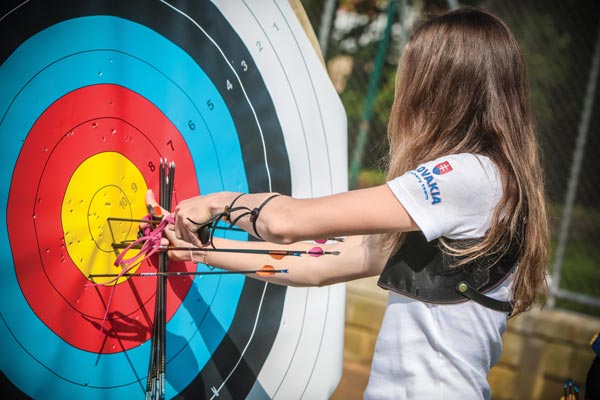
As well as your arrow value, record your ‘process score’ – how good did each of those shots feel?
Part Three: The Scoring Round
We practice to get better. And if we practice properly we will get better, but will we know it? Only if we shoot for score regularly and keep a record of it. Scoring is the only measure we have of our shooting improvement or decline so we must have a place for it in our practice plan.
Choosing an appropriate round to use is not easy. Indoor archery offers some good standard rounds to use and I’d recommend using one of those when indoor practice is all you can do.
For outdoor scoring, you can invent your own. I like shooting 30 arrows at 50 yards using the IFAA hunter target. I also like shooting 30 or 36 arrows at 50 metres using the 80cm FITA target. You may not be ready for those kind of measuring standards, so perhaps 30 arrows at 30 metres using a 60cm FITA target would be more appropriate. Whatever the round, keep records and when you shoot perfect scores on that round, change the round a little by moving further away or selecting a smaller target size.
The target size and distance is not as important as keeping record of your scores. Over a season of practice I like looking over my records to see my scores and also the arrows I used, bow used and the tuning changes I made. Checking old notes can help you find that little ingredient that gets you back to the top again.
There are two kinds of scores to record. There is, of course, the usual arrow-value score but you should also keep your process score. In other words, on how many shots each end did you execute your objective form element satisfactorily? Don’t focus on perfect, just reasonably well. Perfect will come later. You may find that you are executing at the 60 per cent level at the beginning and later, after several weeks, you are at the 80 per cent level. You won’t know until you keep the process score.
A score doesn’t need to be shot every practice session. Two scores a week are sufficient to monitor progress. Some days I’ll just shoot for shot-to-shot rhythm and not keep score. But when I go to my local club I always shoot a serious scoring round like I’d do at a big tournament. Being serious at my club helps me prepare my mental game.
Part Four: Bow Tuning
You and I both know that bows need to be tuned. Some more than others because we’re trying to get the most out of them. Sometimes we push the limits on arrow size and point weight and need to test-shoot to check for positive or negative results and that shooting can be done during your practice session. Don’t forget to log the number of arrows.
Testing your bow can be done before scoring, during scoring or after. Some make and test changes to their bow before scoring to determine if it’s satisfactory. If the setup is significantly worse then continue to make tuning changes. If the bow is better then proceed with scoring. Record these changes.
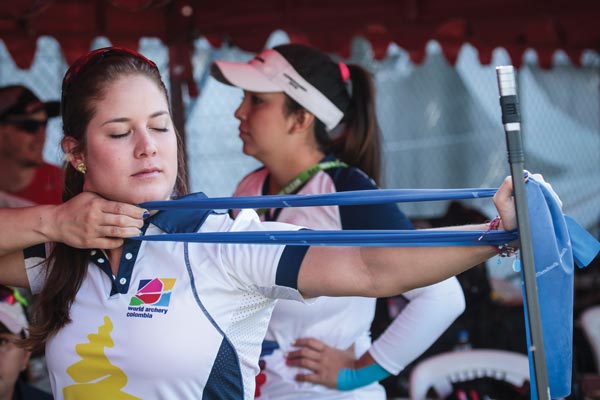
Stretchy bands are useful for warm ups and cooling down
Part Five: End-Of-Practice Blank Bale
Every practice session should end as it began, shooting at a blank bale. Start each session working on an objective form element and when ending that session you should work on that same element. As before, no target or sight should be used during this practice phase so the desired “feel” of the new skill can be gradually engrained into your subconscious mind. Total focus needs to be placed on that one form step. You must do this practice with total discipline if you expect good results. Just mindlessly shooting arrows at a blank bale does nothing to improve your form; consciously focusing on how it feels does.
This closing phase doesn’t need to be long. 10 well-executed shots are sufficient to pass along the muscle actions to the subconscious. Closing with that “feeling” is important for building good form. Doing this four or five times a week over 20 days will enable you to learn and feel that new habit.
However – if you shoot 10 arrows and can’t get one of them to feel good, then you must quit. Stop now so you don’t practice more shots incorrectly. It’s fine to throw in the towel when it’s not going well. It is also smart! Rest a day or two and go after it in your next practice session. Don’t over-practice.
Six: Cool Down
When you’re all done shooting arrows you need to stretch your warm muscles before quitting. This can be done with stretch bands or with isometric-type stretches. A short walk or run is good, too, if you’re also building stamina.
I like to draw my bow with my left hand when I’m done shooting. I draw 10 to 20 times to stimulate my opposing muscle groups to help prevent stress on my spine and also keep all my muscles in tone. Developing muscles on both sides of my body and getting good chiropractic care has helped me eliminate shoulder problems and improve strength and stability. That’s important for both older and younger archers.
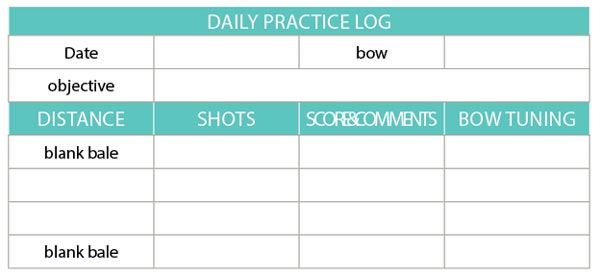
Part Seven: Record Keeping
Recording your bow tuning ensures that you won’t duplicate your efforts later. You will be able to determine that certain tuning changes always have a certain outcome and that can be important for the future. And when a bow gets out of tune because of something you did to it, good records help you get it shooting well again.
Keep simple notes – if you make it complicated you won’t do it. Simple notes about the form elements you work on, how they feel, the progress you make and the scores you shoot enable you to tract progress and make smarter decisions in the future.
I have a simple form that I give to students (shown left). Feel free to copy it, make it better, but most of all, use it.
In Conclusion
There is so much about archery that is mental and it all begins with practice. Certainly, when most people talk about how they need a better mental game they are referring to how their mind works when shooting a scoring arrow, but that is only a small part. Your planning, training and post-tournament evaluation are also part of the mental game. However, it all begins with practice so good luck, get organised and get busy!
This article originally appeared in the issue 115 of Bow International magazine. For more great content like this, subscribe today at our secure online store www.myfavouritemagazines.co.uk

